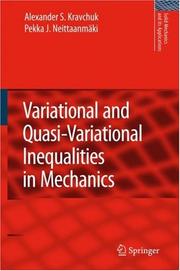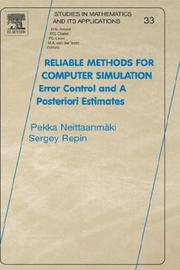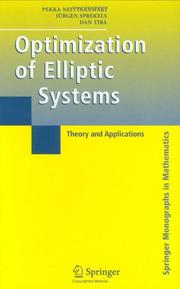| Listing 1 - 10 of 22 | << page >> |
Sort by
|
Book
ISBN: 9516794564 Year: 1985
Abstract | Keywords | Export | Availability | Bookmark
 Loading...
Loading...Choose an application
- Reference Manager
- EndNote
- RefWorks (Direct export to RefWorks)
Book
ISBN: 1281512605 9786611512606 1402087586 1402087578 9048179793 Year: 2008 Publisher: Dordrecht : Springer,
Abstract | Keywords | Export | Availability | Bookmark
 Loading...
Loading...Choose an application
- Reference Manager
- EndNote
- RefWorks (Direct export to RefWorks)
This book is dedicated to Olivier Pironneau. For more than 250 years partial differential equations have been clearly the most important tool available to mankind in order to understand a large variety of phenomena, natural at first and then those originating from human activity and technological development. Mechanics, physics and their engineering applications were the first to benefit from the impact of partial differential equations on modeling and design, but a little less than a century ago the Schrödinger equation was the key opening the door to the application of partial differential equations to quantum chemistry, for small atomic and molecular systems at first, but then for systems of fast growing complexity. Mathematical modeling methods based on partial differential equations form an important part of contemporary science and are widely used in engineering and scientific applications. In this book several experts in this field present their latest results and discuss trends in the numerical analysis of partial differential equations. The first part is devoted to discontinuous Galerkin and mixed finite element methods, both methodologies of fast growing popularity. They are applied to a variety of linear and nonlinear problems, including the Stokes problem from fluid mechanics and fully nonlinear elliptic equations of the Monge-Ampère type. Numerical methods for linear and nonlinear hyperbolic problems are discussed in the second part. The third part is concerned with domain decomposition methods, with applications to scattering problems for wave models and to electronic structure computations. The next part is devoted to the numerical simulation of problems in fluid mechanics that involve free surfaces and moving boundaries. The finite difference solution of a problem from spectral geometry has also been included in this part. Inverse problems are known to be efficient models used in geology, medicine, mechanics and many other natural sciences. New results in this field are presented in the fifth part. The final part of the book is addressed to another rapidly developing area in applied mathematics, namely, financial mathematics. The reader will find in this final part of the volume, recent results concerning the simulation of finance related processes modeled by parabolic variational inequalities.
Differential equations, Partial. --- Engineering mathematics. --- Physics. --- Natural philosophy --- Philosophy, Natural --- Physical sciences --- Dynamics --- Engineering --- Engineering analysis --- Mathematical analysis --- Mathematics --- Partial differential equations --- Differential equations, partial. --- Numerical and Computational Physics, Simulation. --- Mathematical and Computational Engineering. --- Partial Differential Equations. --- Mathematical Modeling and Industrial Mathematics. --- Applied mathematics. --- Partial differential equations. --- Mathematical models. --- Models, Mathematical --- Simulation methods --- Modeling --- Numerical simulation
Book
Year: 1980 Publisher: Bonn Universität Bonn. Sonderforschungsbereich 72
Abstract | Keywords | Export | Availability | Bookmark
 Loading...
Loading...Choose an application
- Reference Manager
- EndNote
- RefWorks (Direct export to RefWorks)
Book
Year: 1980 Publisher: Bonn Universität Bonn. Sonderforschungsbereich 72
Abstract | Keywords | Export | Availability | Bookmark
 Loading...
Loading...Choose an application
- Reference Manager
- EndNote
- RefWorks (Direct export to RefWorks)

ISBN: 1281070114 9786611070113 1402063776 1402063768 9048176190 Year: 2007 Publisher: Dordrecht : Springer,
Abstract | Keywords | Export | Availability | Bookmark
 Loading...
Loading...Choose an application
- Reference Manager
- EndNote
- RefWorks (Direct export to RefWorks)
The variational method is a powerful tool to investigate states and processes in technical devices, nature, living organisms, systems, and economics. The power of the variational method consists in the fact that many of its sta- ments are physical or natural laws themselves. The essence of the variational approach for the solution of problems rel- ing to the determination of the real state of systems or processes consists in thecomparisonofclosestates.Theselectioncriteriafortheactualstatesmust be such that all the equations and conditions of the mathematical model are satis?ed. Historically, the ?rst variational theory was the Lagrange theory created to investigate the equilibrium of ?nite-dimensional mechanical systems under holonomic bilateral constraints (bonds). The selection criterion proposed by Lagrange is the admissible displacement principle. In accordance with this principle, the work of the prescribed forces (supposed to be constant) on in?nitesimally small, kinematically admissible (virtual) displacements is zero. It is known that equating the virtual work performed for potential systems to zero is equivalent to the stationarity conditions for the total energy of the system. The transition from bilateral constraints to unilateral ones was performed by O. L. Fourier. Fourier demonstrated that the virtual work on small dist- bances of a stable equilibrium state of a mechanical system under unilateral constraints must be positive (or, at least, nonnegative). Therefore, for such a system the corresponding mathematical model is reduced to an inequality and the problem becomes nonlinear.
Engineering. --- Mechanics. --- Computational intelligence. --- Continuum mechanics. --- Mechanical engineering. --- Mechanical Engineering. --- Continuum Mechanics and Mechanics of Materials. --- Computational Intelligence. --- Engineering, Mechanical --- Engineering --- Machinery --- Steam engineering --- Mechanics of continua --- Elasticity --- Mechanics, Analytic --- Field theory (Physics) --- Intelligence, Computational --- Artificial intelligence --- Soft computing --- Classical mechanics --- Newtonian mechanics --- Physics --- Dynamics --- Quantum theory --- Construction --- Industrial arts --- Technology --- Mechanics, Analytic. --- Variational inequalities (Mathematics) --- Deformations (Mechanics) --- Elastic solids --- Mechanics --- Rheology --- Strains and stresses --- Structural failures --- Inequalities, Variational (Mathematics) --- Calculus of variations --- Differential inequalities --- Analytical mechanics --- Kinetics --- Mechanics, Applied. --- Classical Mechanics. --- Solid Mechanics. --- Applied mechanics --- Engineering mathematics

ISBN: 9780444513762 0444513760 9781435601017 1435601017 0080540503 9780080540504 1281019089 9781281019080 9786611019082 6611019081 Year: 2004 Publisher: Amsterdam ; San Diego, CA : Elsevier,
Abstract | Keywords | Export | Availability | Bookmark
 Loading...
Loading...Choose an application
- Reference Manager
- EndNote
- RefWorks (Direct export to RefWorks)
Recent decades have seen a very rapid success in developing numerical methods based on explicit control over approximation errors. It may be said that nowadays a new direction is forming in numerical analysis, the main goal of which is to develop methods ofreliable computations. In general, a reliable numerical method must solve two basic problems: (a) generate a sequence of approximations that converges to a solution and (b) verify the accuracy of these approximations. A computer code for such a method must consist of two respective blocks: solver and checker.In this book, we are chie
Numerical analysis. --- Error-correcting codes (Information theory) --- Approximation theory. --- Theory of approximation --- Functional analysis --- Functions --- Polynomials --- Chebyshev systems --- Codes, Error-correcting (Information theory) --- Error-detecting codes (Information theory) --- Forbidden-combination check (Information theory) --- Self-checking codes (Information theory) --- Artificial intelligence --- Automatic control --- Coding theory --- Information theory --- Mathematical analysis

ISBN: 1280743743 9786610743742 0387272364 0387272356 1441920935 Year: 2006 Publisher: New York : Springer,
Abstract | Keywords | Export | Availability | Bookmark
 Loading...
Loading...Choose an application
- Reference Manager
- EndNote
- RefWorks (Direct export to RefWorks)
This monograph provides a comprehensive and accessible introduction to the optimization of elliptic systems. This area of mathematical research, which has many important application in science and technology, has experienced an impressive development during the last two decades. This monograph aims to address some of the pressing unsolved questions in the field. The exposition concentrates along two main directions: the optimal control of linear and nonlinear elliptic equations, and problems involving unknown and/or variable domains. Throughout this monograph, the authors elucidate connections between seemingly different types of problems. One basic feature is to relax the needed regularity assumptions as much as possible in order to include larger classes of possible applications. The book is organized into six chapters that give a gradual and accessible presentation of the material, and a special effort is made to present numerous examples. This monograph is addressed primarily to mathematics graduate students and researchers, however much of this material will also prove useful for scientists from physics, mechanics, and engineering.
Mathematics. --- Partial differential equations. --- Applied mathematics. --- Engineering mathematics. --- Mathematical optimization. --- Optimization. --- Partial Differential Equations. --- Applications of Mathematics. --- Optimization (Mathematics) --- Optimization techniques --- Optimization theory --- Systems optimization --- Mathematical analysis --- Maxima and minima --- Operations research --- Simulation methods --- System analysis --- Engineering --- Engineering analysis --- Partial differential equations --- Math --- Science --- Mathematics --- Differential equations, Elliptic --- Differential equations, Linear. --- Numerical solutions. --- Linear differential equations --- Linear systems --- Differential equations, partial.
Book
ISBN: 9400775814 Year: 2014 Publisher: Dordrecht, Netherlands : Springer,
Abstract | Keywords | Export | Availability | Bookmark
 Loading...
Loading...Choose an application
- Reference Manager
- EndNote
- RefWorks (Direct export to RefWorks)
The importance of accuracy verification methods was understood at the very beginning of the development of numerical analysis. Recent decades have seen a rapid growth of results related to adaptive numerical methods and a posteriori estimates. However, in this important area there often exists a noticeable gap between mathematicians creating the theory and researchers developing applied algorithms that could be used in engineering and scientific computations for guaranteed and efficient error control. The goals of the book are to (1) give a transparent explanation of the underlying mathematical theory in a style accessible not only to advanced numerical analysts but also to engineers and students; (2) present detailed step-by-step algorithms that follow from a theory; (3) discuss their advantages and drawbacks, areas of applicability, give recommendations and examples.
Computer science. --- Numerical analysis. --- Computer mathematics. --- Physics. --- Computational intelligence. --- Computer Science. --- Numeric Computing. --- Computational Science and Engineering. --- Numerical Analysis. --- Numerical and Computational Physics. --- Computational Intelligence. --- Mathematical analysis --- Intelligence, Computational --- Artificial intelligence --- Soft computing --- Natural philosophy --- Philosophy, Natural --- Physical sciences --- Dynamics --- Computer mathematics --- Discrete mathematics --- Electronic data processing --- Informatics --- Science --- Mathematics --- Electronic data processing. --- Engineering. --- Numerical and Computational Physics, Simulation. --- Construction --- Industrial arts --- Technology --- ADP (Data processing) --- Automatic data processing --- Data processing --- EDP (Data processing) --- IDP (Data processing) --- Integrated data processing --- Computers --- Office practice --- Automation --- Numerical calculations --- Mathematical models. --- Verification.
Book
ISBN: 9048125170 9400731116 9786612838019 1282838016 9048125189 Year: 2010 Publisher: Dordrecht ; New York : Springer,
Abstract | Keywords | Export | Availability | Bookmark
 Loading...
Loading...Choose an application
- Reference Manager
- EndNote
- RefWorks (Direct export to RefWorks)
This monograph is devoted to the exposition of new ways of formulating problems of structural optimization with incomplete information and techniques of solution. Research results concerning the optimum shape and structural properties of the bodies subjected to external loadings are recapitulated. Problems of optimal design with incomplete information, accounting for the interaction between the structure and its environment, properties of materials, existence of initial damages and damage accumulation are studied. This volume treats overcoming the corresponding mathematical difficulties caused by raising local functionals. Most of the book is devoted to the minimax approach using worst case scenarios, i.e. the so-called guaranteed approach. However, the probabilistic approach, that does not guarantee the result, is also described in the monograph, because it gives more “optimistic” results. Also, the mixed probabilistic guaranteed approach is discussed and applied for the solution of structural optimization problems with uncertainties.
Structural optimization. --- Structural optimization --- Civil & Environmental Engineering --- Engineering & Applied Sciences --- Civil Engineering --- Computer Science --- Structural design. --- Optimal structural design --- Optimization, Structural --- Optimization of structural systems --- Optimum design of structures --- Optimum structural design --- Optimum structures --- Structures, Optimum design of --- Engineering. --- Computer-aided engineering. --- Calculus of variations. --- Computational intelligence. --- Structural mechanics. --- Engineering design. --- Computational Intelligence. --- Calculus of Variations and Optimal Control; Optimization. --- Computer-Aided Engineering (CAD, CAE) and Design. --- Structural Mechanics. --- Engineering Design. --- Design, Engineering --- Engineering --- Industrial design --- Strains and stresses --- Architectural engineering --- Engineering, Architectural --- Structural mechanics --- Structures, Theory of --- Structural engineering --- Intelligence, Computational --- Artificial intelligence --- Soft computing --- Isoperimetrical problems --- Variations, Calculus of --- Maxima and minima --- CAE --- Construction --- Industrial arts --- Technology --- Design --- Data processing --- Engineering design --- Architectural design --- Structural design
Multi
ISBN: 9789400775817 9400775814 Year: 2014 Publisher: Dordrecht, Netherlands : Springer,
Abstract | Keywords | Export | Availability | Bookmark
 Loading...
Loading...Choose an application
- Reference Manager
- EndNote
- RefWorks (Direct export to RefWorks)
The importance of accuracy verification methods was understood at the very beginning of the development of numerical analysis. Recent decades have seen a rapid growth of results related to adaptive numerical methods and a posteriori estimates. However, in this important area there often exists a noticeable gap between mathematicians creating the theory and researchers developing applied algorithms that could be used in engineering and scientific computations for guaranteed and efficient error control. The goals of the book are to (1) give a transparent explanation of the underlying mathematical theory in a style accessible not only to advanced numerical analysts but also to engineers and students; (2) present detailed step-by-step algorithms that follow from a theory; (3) discuss their advantages and drawbacks, areas of applicability, give recommendations and examples.
Numerical analysis --- Mathematical physics --- Applied physical engineering --- Computer science --- Information systems --- Artificial intelligence. Robotics. Simulation. Graphics --- Computer. Automation --- neuronale netwerken --- fuzzy logic --- cybernetica --- theoretische fysica --- computers --- informatica --- informaticaonderzoek --- KI (kunstmatige intelligentie) --- ingenieurswetenschappen --- computerkunde --- robots --- numerieke analyse --- gegevensverwerking --- AI (artificiële intelligentie) --- Numerical calculations --- Mathematical models. --- Verification.
| Listing 1 - 10 of 22 | << page >> |
Sort by
|

 Search
Search Feedback
Feedback About UniCat
About UniCat  Help
Help News
News